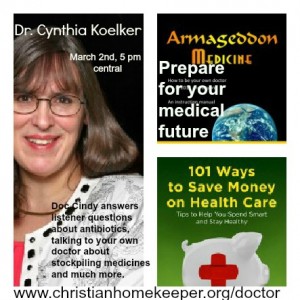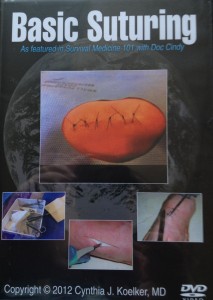If you fear that one day you may be on your own, and if you want to make sure you or a loved won’t die of diarrhea, you must know how to cure C diff. Without treatment, this infection is among the most lethal diarrheal illnesses in the United States today. Not many years ago C diff was confined to hospitals and nursing homes; now it occurs in the general community. Without appropriate treatment, the diarrhea may linger and patients may die of dehydration or electrolyte imbalance.
Clostridium difficile infection generally occurs only after taking antibiotics, and requires a different antibiotic to cure it (metronidazole 500 mg 3x/day or vancomycin 125 4x/day for 10–14 days). These antibiotics will be in short supply, should society or modern medicine collapse. Unfortunately, at times even these special antibiotics are ineffective.
C diff produces two types of toxins, which cause inflammation of the colon and increased fluid secretion. The susceptibility to these toxins varies from person to person, and seems to worsen with age. New and more virulent strains have emerged, making the infection even harder to treat. Although certain antibiotics are able to kill the active bacteria, they are ineffective against spores, which can lay dormant and cause infection again later.
If antibiotics won’t cure the illness, is there any other treatment? Fortunately, yes. First though, a question: why doesn’t everyone who harbors C diff spores in their gut succumb to infection? You may already carry them. So may I. But why aren’t we sick?
The answer lies in the “normal flora” of the bowel – that is, the normal, “healthy” bacteria which work with our own immune system to ward off potentially invasive disease. If you have enough “good” bacteria, the “bad” ones can’t flourish. Antibiotics such as amoxicillin or doxycycline (or nearly any common antibiotic) kill many of these beneficial germs, upsetting the balance between helpful and harmful bacteria, sometimes resulting in C diff gaining a foothold within the intestine.
So if the answer is more good bacteria, how can this be accomplished? Live bacterial cultures (yogurt, probiotics) can help, but a more drastic approach may be required – which brings us to why I’m writing today. I’d like to update you with essential information from an article in this month’s Cleveland Clinic Journal of Medicine.
In Chapter 30 of Armageddon Medicine I address treating Clostridium difficile colitis with fecal transplantation. The recent Cleveland Clinic article outlines additional specifics.
Fecal transplantation involves instilling “blenderized feces” from a healthy donor into the GI tract of the infected person. Such feces contain normal flora (or germs), which are expected to multiply and take over, reducing or eliminating the potential for C diff to cause illness. The Cleveland Clinic protocol recommends considering fecal transplantation for patients who have had recurrent or severe C diff infections unresponsive to traditional antibiotic therapy. But in an era lacking vancomycin (or even more advanced antibiotics) fecal transplantation should be considered earlier on.
If your mother takes Augmentin for pneumonia and develops a foul-smelling diarrhea afterward that doesn’t resolve within a few days, she likely has C diff. Anyone who takes an antibiotic for any reason is potentially susceptible.
If you’re going to consider fecal transplantation, the donor must be selected with caution. A spouse/partner is first choice, other family household member second, or any other healthy donor third.
The Clinic’s list of exclusion criteria for donors is extensive. No one with HIV or hepatitis should be considered, nor anyone with known exposure in the past year. Anyone who engages in high-risk behaviors should be avoided as well (high-risk sexual behavior, use of recreational drugs, tattooing within the past 6 months, any history of incarceration). Likewise, don’t select a donor who has a history of bowel disease such as colitis, irritable bowel, or cancer. It’s only common sense that people with current illnesses should be excluded as donors.
Other important considerations are avoiding donors who themselves have taken antibiotics within the past three months, or anyone who has recently ingested a substance or food to which the recipient is allergic. In general, the healthiest person available would be the best choice.
The donor is also advised to take a laxative such as milk of magnesia the night before the transplantation. The recipient is to stop oral metronidazole or vancomycin three days before the procedure, and to use a bowel prep with polyethylene glycol (a large dose of MiraLAX given orally) the night before to remove as much stool as possible. Then the morning of the transplantation a dose of loperamide (Imodium) is given to aid retention of the transplanted feces.
The feces should be obtained from the donor (with health care workers wearing gown/gloves/mask if available), then blenderized with normal saline or whole milk until smooth, then filtered through gauze pads or a coffee filter. In the hospital 1-2 tablespoons of the liquid obtained is given through an endoscopic tube to the stomach. I would not advise this approach outside the hospital.
However, the liquefied feces may be given rectally as well. In the hospital this is accomplished using a colonoscope. However, at home this is done via a retention enema, instilling 8 to 16 ounces of the liquid from the strained feces, repeated every 3 to 5 days as needed until diarrhea resolves. The patient should be instructed to restrain from defecating as long as possible after the enema is instilled; some leakage is likely to occur.
How well does this approach work? In patients who have recurrent C diff infection it works better than traditional antibiotics (vancomycin). I expect it would work equally well on patients who suffer their first round of C diff and who would normally be treated with oral antibiotics. (A study of these patients is not likely to be done, however – who wouldn’t prefer a pill?)
Also remember, prevention is the best answer. At TEOTWAWKI antibiotics should be reserved for life-threatening infections, not every little sniffle that comes along.
Copyright © 2013 Cynthia J. Koelker, MD












